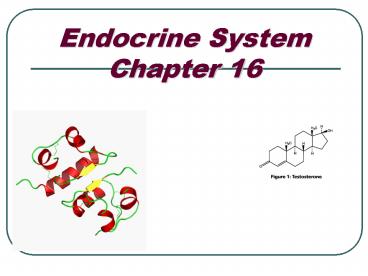Endocrine System Chapter 16 - PowerPoint PPT Presentation
1 / 21
Title: Endocrine System Chapter 16
1
Endocrine SystemChapter 16
2
Hormones
- Released from glands
- Looking for receptors on cells, or target cells
- Two types of hormones
- Steroid cholesterol
- Non steroid proteins,modified amino acids
3
Peptide and Steroid Hormones Have Different Modes
of Signaling
- Non-Steroid (Peptide) Hormones are protein based
hormones. - Responses are faster but do not last as long.
- Steroid Hormones are lipid based
- These responses take longer to initiate but have
a longer duration.
4
Hormones in Action
Nonsteroid hormone (first messenger)
Steroid Hormone
Receptor
Target cell membrane
Target cell membrane
Receptor
cAMP (second messenger)
Hormone-receptor complex
Altered cellular function
Nucleus
Enzyme activities
DNA
Altered cellular function
Protein synthesis
Nucleus
Cytoplasm
Cytoplasm
mRNA
5
Endocrine Glands
Pineal gland The pineal gland releases melatonin,
which is involved in rhythmic activities, such as
daily sleep-wake cycles.
Hypothalamus The hypothalamus makes hormones that
control the pituitary gland. In addition, it
makes hormones that are stored in the pituitary
gland.
Thyroid The thyroid produces thyroxine, which
regulates metabolism.
Pituitary gland The pituitary gland produces
hormones that regulate many of the other
endocrine glands.
Pancreas The pancreas produces insulin and
glucagon, which regulate the level of glucose in
the blood.
Parathyroid glands These four glands release
parathyroid hormone, which regulate the level of
calcium in the blood.
Ovary The ovaries produce estrogen and
progesterone. Estrogen is required for the
development of secondary sex characteristics and
for the development of eggs. Progesterone
prepares the uterus for a fertilized egg.
Thymus During childhood, the thymus releases
thymosin, which stimulates Tcell development.
Testis The testes produce testosterone, which is
responsible for sperm production and the
development of male secondary sex characteristics
Adrenal glands The adrenal glands release
epinephrine and nonepinephrine, which help the
body deal with stress.
6
Animals Have Two Systems of Internal
Communication and Regulation.
- Nervous System
- Movement of body parts as a quick response to
sudden environmental changes. - Pulling your hand a way from a hot flame.
- Endocrine System
- Longer lasting and slower response
- Chemical response
- Homeostasis depends on the overlap of the nervous
and endocrine systems.
7
- The endocrine system is made up of glands that
release their products into the bloodstream.
These products deliver messages throughout the
body. - Nervous System Endocrine System
- Neuron Bloodstream
- Fast Slow
- Small of cells effected Large of cells
- effected
8
Endocrine Glands
- Endocrine glands
- Ductless glands that secrete substances directly
into the blood stream. - Pancreas secretes insulin into the blood stream
- Exocrine Glands
- These glands have ducts
- Secrete mucus, sweat from glands through ducts
- Pancreatic duct secretes digestive enzymes.
9
Nervous System and Endocrine System are Closely
Related
- Many endocrine organs contain nervous tissue
composed of neurosecretory cells (nervous system
and endocrine system working in concert) - These cells secrete hormones in response to a
stimulus. - The suckling of an infant stimulates a nervous
response which is sent to the brain. - The result is the hypothalamus tells the
pituitary gland to secrete oxytocin (a chemical
signal) that causes the secretion of milk. - Epinephrine is a hormone and a neurotransmitter.
- Produced by adrenal glands as the fight or
flight hormone. - Also acts as a neurotransmitter that is involved
in nerve cell communication.
10
Positive and Negative Feedback Loops are
Important in Maintaining Homeostasis.
- A rise in blood calcium causes calcitonin to be
released from the thyroid gland which triggers
calcium to be put into bone formation.
(osteoblasts) - A lack of blood calcium causes the parathyroid
gland to release parathyroid hormone to release
calcium back into blood from bones. (osteoclasts)
11
Calcium Balance
12
GoiterThyroid enlarges due to lack of iodine,
necessary for thyroid hormone production (pg. 504)
13
Chemical Signals Are Important in the Endocrine
System
- Some chemicals have to travel long distances to
their target cells while others act locally. - The receptors on the target cells are specific
and the same hormone can elicit different
responses depending on the target cell and its
receptor. - Acetylcholine
- Skeletal muscle contraction
- Relaxation of heart muscle
14
Local Regulators
- Growth Factors
- Growth hormone (secreted by anterior pituitary
somatotrophs) stimulates rapid entrance of amino
acids from blood into cells by stimuating growth
factors production in liver - Accelerated protein anabolism within cells
increases growth rate - Nitric Oxide
- Stimulate cell destruction in the immune system
- Stimulate vasodilatation in the circulatory
system - Functions as a neurotransmitter in the nervous
system. - Prostaglandins
- Modified fatty acids derived from lipids
- Stimulate uterine contractions, fever,
inflammation and the sensation of pain. - PGE and PGF are antagonistic and stimulate the
contraction and dilation of blood vessels in the
lung. - Pheromones
- Chemical signals that serve as communication
between animals. - Warning signals, territorial ,markers.
15
Anterior Pituitary
- Produces its own hormones and releases
- Growth Hormone-Stimulate growth factors produced
in the liver called somatomedins which stimulate
cartilage and bone growth. - Excessive GH production causes gigantism and
acromegaly. - GH deficiency causes hypopituitary dwarfism.
16
- Too much GH
- Not enough GH
17
Hypothalamus and Pituitary Glands.
- Hypothalamus
- Controls the pituitary
- Neurosecretory cells release hormones that
control the pituitary gland. - Important connection between the endocrine and
nervous system. - Pituitary
- Master Gland
- Anterior and Posterior
- Posterior pituitary stores and releases hormones
produced by the hypothalamus. - Examples
- ADH water absorption in the kidney
- Oxytocin-uterine contractions and milk production
in the mammary glands.
18
Pancreas
19
(No Transcript)
20
(No Transcript)
21
Overview
The Endocrine System
regulates
By means of the
By means of the
By means of the
By means of the
- By means
- of the
By means of the































